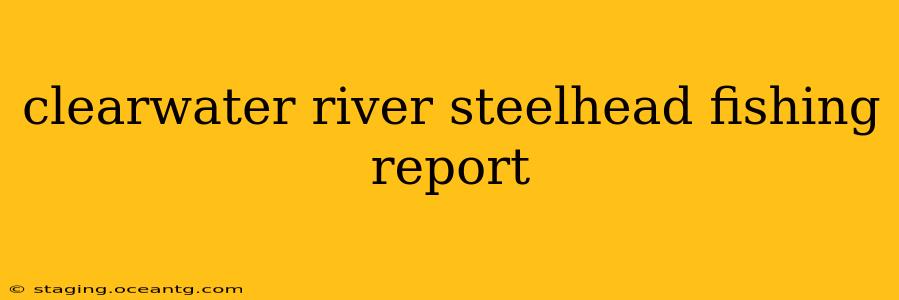The Clearwater River, a renowned tributary of the Snake River in Idaho, is a celebrated destination for steelhead fishing. Its diverse habitat and robust steelhead runs attract anglers from across the country. This report offers an up-to-date overview of Clearwater River steelhead fishing conditions, encompassing recent catches, fishing techniques, and crucial considerations for a successful trip. Remember that fishing regulations change, so always check the Idaho Fish and Game website for the most current rules and regulations before you go.
What are the current Clearwater River steelhead fishing conditions?
Current conditions vary considerably depending on the time of year and specific section of the Clearwater River. Generally, fall and winter see the bulk of steelhead runs, with spring offering some later opportunities. Water levels and clarity play significant roles in fishing success. High, muddy water often makes fishing challenging, while clear, moderate flows are typically ideal. Recent rainfall or snowmelt can drastically impact river conditions. Checking local fishing reports, contacting guide services, and monitoring river gauges are crucial for up-to-date information. Remember that conditions can change dramatically in short periods.
Where are the best places to fish for steelhead on the Clearwater River?
The Clearwater River system offers many productive steelhead fishing spots, each with its own characteristics:
- Lower Clearwater: This section is known for its accessibility and often produces good catches, especially during peak runs.
- Middle Clearwater: This stretch can be more challenging to access but often offers less fishing pressure and potentially larger fish.
- North Fork Clearwater: This tributary is known for its wild steelhead and offers a more secluded fishing experience.
Specific locations within these areas are often kept secret by experienced anglers, but local fishing shops and guides can provide valuable insight into productive spots while respecting the need for conservation and responsible fishing practices.
What are the best techniques for catching steelhead in the Clearwater River?
Steelhead fishing techniques vary depending on water conditions and the angler's preference. Popular methods include:
- Drift fishing: This technique involves using a bobber and bait or lure to drift along the river current.
- Plunking: A stationary technique using a weighted setup on the bottom.
- Back bouncing: This method uses a weighted lure that bounces along the river bottom.
- Spinning and casting: Using various lures like spoons, spinners, and plugs.
Choosing the right technique requires an understanding of water flow, depth, and the type of structure present.
What kind of gear is best for Clearwater River steelhead fishing?
Successfully fishing for Clearwater steelhead requires durable and appropriate gear:
- Rods: Medium-heavy to heavy action rods are suitable for handling the strength of steelhead.
- Reels: Reels with a strong drag system are essential for fighting large fish.
- Line: Braided line is a popular choice due to its sensitivity and strength.
- Leaders: Steel leaders are recommended to prevent bite-offs.
- Terminal Tackle: This includes hooks, weights, swivels, and appropriate lures or bait (such as roe, eggs, or jigs).
Investing in quality gear improves the chances of landing a fish and provides a more enjoyable fishing experience.
What is the best time of year to fish for steelhead in the Clearwater River?
The best time to fish for steelhead in the Clearwater River is generally during the fall and winter months, though some fish can be caught in spring. The timing of the runs can vary from year to year depending on weather patterns and water temperatures. The peak of the run often occurs in October and November, but significant numbers of fish can still be caught into December and even later, depending on conditions.
What are the regulations for steelhead fishing in the Clearwater River?
Fishing regulations in the Clearwater River are strictly enforced. Check the Idaho Fish and Game website for up-to-date information on license requirements, bag limits, size restrictions, and any special regulations that may be in place. It's crucial to be aware of and abide by these regulations to ensure the sustainability of the steelhead population and maintain access to this fantastic fishery. Knowing the regulations is not only important for responsible fishing, but also to avoid potential fines.
What are some tips for successful steelhead fishing on the Clearwater River?
- Hire a guide: Consider hiring a local guide, especially if you're unfamiliar with the river.
- Check weather and water conditions: River levels and clarity significantly affect fishing success.
- Be patient: Steelhead fishing can be challenging, and patience is key.
- Practice catch and release: Help maintain the steelhead population by practicing responsible catch and release techniques.
- Respect the environment: Leave the area cleaner than you found it.
By following these tips, you’ll increase your chances of a successful and memorable Clearwater River steelhead fishing trip. Remember to always check for current fishing reports and regulations before heading out.
